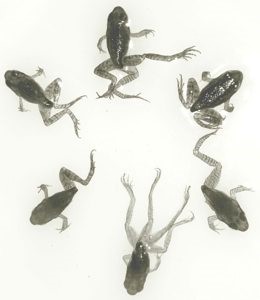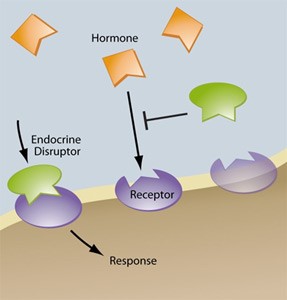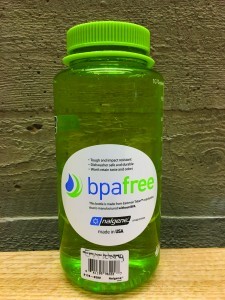Endocrine Disrupting Chemicals(EDCs)
Posted by Mekdelawit Messay Deribe
December 11,2017
More than 25 years ago, a group of school kids with their teachers went out on a field trip and observed some very unusual deformities in frogs. Some had three legs, some had odd extensions and looked very “abnormal”. I can’t imagine how confusing it must have been for the kids and the teachers back then. But since then scientists have linked these deformities in aquatic animals with chemical substances known as Endocrine Disrupting Chemicals or EDCs for short.

Deformed frogs found in waters with EDCs present
EDCs are chemical substances that mimic the role of hormones in our bodies. Many living organisms including human beings have a system of glands and hormones in their bodies, collectively known as the endocrine system which control basic body functions such as reproduction, metabolism, sleep, growth, stress and many others. The hormones in our bodies work the same way as like a lock and key. Specific hormones fit specific receptors. EDCs cause disruption by tricking the body into thinking they are hormones and result in unusual body responses.

The lock and key model, showing how EDCs trick the body into thinking they are hormones
EDCs have now been linked to feminization of aquatic animals and human beings, de-masculinization and slow onset of puberty in males, early onset of puberty in females, birth defects, abnormality of sexual organs, fertility issues, increase in cancer rates, autism, neurological issues, learning disorders, metabolic issues, obesity, diabetes and so much more. Sperm count has decreased by 50% in the past 50 years. As one researcher pointed out very ironically “ You are not the man that your grandfather was!”
What is worse is exposure to EDCs can happen virtually anywhere, anytime; be it through the air we breathe, water and food we consume or products we use. Some EDCs are even transferred from mothers to babies during conception. Runoff from agricultural lands and animal feed lots and landfills leach EDCs into the Environment. Many EDCs are found in pharmaceuticals which find their way to rivers and water ways affecting aquatic life. Since water treatment plants are not designed to filter these chemicals they eventually come back to us through our taps too.
• Plastics
• hair sprays and other fragrances,
• personal care products like shampoos, anti-bacterial soaps, lotions, sunscreens, tooth paste, nail polish,
• industrial chemicals such as fungicides, pesticides, detergents, fire retardants all contain known EDCs.
In addition, Soy based products for animals feed and human consumption, soy-based baby formulae, all contain plant Estrogen; a known female hormone. Estrogen intake further skews the hormone balance in the body. These EDCs are biologically active at very small concentrations and even trace amounts can alter body functions.
Now you might be thinking that if these chemicals have such adverse effects on human beings and other life in our environment, why have they not been banned? Well, that is complicated. Industries related to the production and use of these chemicals are lobbying heavily against the ban saying “the dose makes the poison”. In short, they are saying that that these chemicals are not dangerous to human beings as long as they are within “acceptable” limits. In addition, EDCs do not have any immediate effect on organisms, instead they accumulate and move up the food chain. This has made it hard to provide instant proof against EDCs. However, this is not to say that nothing has been done so far. Canada has banned the use of plastics with known EDCs in the use of baby bottles. It is also common to see plastic bottles labelled “ BPA free” these days(BPA is a common EDC found in many plastics). EDCs have been on the agenda of the EU since 1999 and are still under discussion.

Plastic water bottle labeled “bpa free”
There is an old saying in my country which roughly translates to “ when two elephants fight, the grass suffers the most”. With wealthy corporations lobbying against banning EDCs and governments being reluctant to pass regulations, the public is caught in between and suffers the most. Be that as it may with the politics behind EDCs, what can we, as individuals, do to reduce our exposure to EDCs? Here are some tips.
1. DO NOT flush pharmaceuticals down the toilet. Double bag them before putting it in the trash or better yet, return them to pharmacy.
2. Limit your exposure to hormones: buy organic and natural products.
3. Avoid using plastics: store food in glass containers, use glass water bottles, do not microwave food in plastic, use ceramic or glass cook ware.
4. Wash fruits and vegetables before eating
5. Use natural cleaning products, avoid synthetic fragrances such as air fresheners and fabric softeners.
6. Avoid anti-bacterial soaps, regular soap works just fine.
7. Use fluoride-free toothpaste.
8. Avoid compounds which are known EDCs. Some of these are BPA, PFCs, triclosan, Phthalates, Paraben, steroid hormones, dioxin, mercury, lead, perchlorates, Atrazine…the list goes on.
9. Read more about EDCs, be knowledgeable and spread the word.
10. Finally pressure your government to ban EDCs and push for EDC-free products.
I hope these tips are an eye opener for you as they were for me. Learn more about EDCs by following this link.
Wageningen,Netherlands



